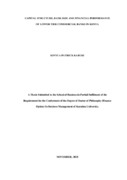| dc.description.abstract | The banking sector is recognized as the most visible source of finance and key to global trade and economic growth. Banking institutions play a notable role in building both domestic and global economies by ensuring credit is available to finance businesses and households. However, the performance of banking sector from global, regional and local perspective has
been deteriorating with small banks being affected the most. The phenomenon has been linked to the manner banks of different sizes finances their operations (capital structure), but remains debatable among scholars. It is argued that a properly designed capital structure defines the manner in which a bank seeks funds from various sources to finance its operations without
risking high costs of capital that may jeopardize its performance. In Kenya, the capital structure has been in the center of operational performance of commercial banks in Kenya. The Kenyan banking sector is categorized into three tiers, tier I, II and III based on bank size. However, the profitability of the tier II and III have been declining resulting to an enquiry to whether, the size
of the bank has any influence on capital structure and performance of the banks. This study therefore sought to determine the moderating influence of bank size on the relationship between capital structure and profitability of lower tier commercial banks in Kenya. The specific objectives of the study were to assess the influence of internal equity capital; the influence of short term debt capital; the influence of external equity capital and the influence of long term equity capital on profitability of lower tier commercial banks in Kenya. Appropriate null hypotheses were developed for each objective. This study was anchored in pecking order theory, Modigliani and Miller Capital Structure Theory, trade-off theory of capital structure, the net income approach, Dynamic Trade-off Theory and Agency Cost Theory. Pragmatism research philosophy was adopted where the study concurrently employed descriptive and explanatory research design. The study population was 37 commercial banks in Tier II and III in Kenya that were fully operational from 2016 to 2020 and a census of all the 37 banks was conducted. The main data of study was secondary data; whereby primary data was also collected for triangulation purposes. The validity of the secondary data was enhanced by collecting data from audited and certified sources while the reliability of the questionnaire was ascertained through use of Cronbach Alpha coefficient. Data analysis involved descriptive and inferential statistics. Descriptive statistics entailed percentages, means, standard deviations, minimums, maximums, Skewness and Kurtosis. The inferential statistics comprised of multilevel mixed model analysis and hierarchical multiple linear models. A range of model and data diagnostic tests were conducted before estimating the study’s regression models and included the Mixed ANOVA, utocorrelation, normality tests, heteroscedasticity tests, multicollinearity tests and stationarity tests. The results were presented using tables and figures. The study found that internal equity had a positive and significant effect on net profit margin of lower tier commercial banks (β=.429, p=.000<0.05) but bank size did not moderate the effect of internal equity on net profit margin of lower tier commercial banks in Kenya (β=.148, p=600>0.05). External equity had a positive and significant effect on net profit margin of lower tier commercial banks (β=.229, p=.036<0.05). Bank size positively and significantly moderates the relationship between external equity and performance of lower tier banks in Kenya (β=2.350, p =.000<0.05) and has an enhancing effect
on external equity. Long term debt had a negative and significant effect on the financial performance of lower tier commercial banks (β=-.966, p=.029<0.05). Bank size moderates the effect of long term debt on financial performance of lower tier commercial banks in Kenya (β= .695, p-value=.024<0.05) and has an antagonistic effect on long term debt capital. Nonetheless,
short term debt had a positive but insignificant effect on the financial performance of lower tier commercial banks (β=.067, p=.625>0.05). Bank size moderated the effect of short term debt on financial performance of lower tier commercial banks (β=.127, p=.019<0.05) with strengthening effect. Thus, the study concludes that bank size moderates the effect of external
equity, short term debt and long term debt on financial performance of lower tier commercial banks but does not moderate the effect of internal equity on financial performance of lower tier commercial banks. The study recommends that lower tier commercial banks need to encourage xxii its shareholders to re-invest back their earnings rather than consuming them as dividends as internal equity is affordable and readily available when the bank is in urgent financial need. The study further recommends that a bank should keenly evaluate when to use external equity funding though external equity funding may be costlier. Lower tier commercial banks may also employ long term sources like equity shares, debentures, preference shares and public deposits as they are usually less prone to short term shocks as it is secured by formally established contractual terms. In addition, lower tier commercial banks may also need to diversify their product and service portfolio to expand their aggregate asset base and competitiveness in the market so that they can withstand financial and market shocks. The study offers great value to the management of lower commercial banks and other players in the sector. The regulators including the CBK may get insightful information that would assist in formulation of policy on ideal financing structures for lower tier commercial banks. The study also provides a worthy benchmark to future research work on capital structure and profitability of small and medium
sized commercial banks | en_US |
